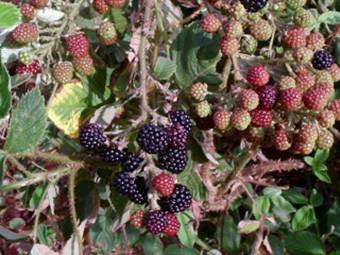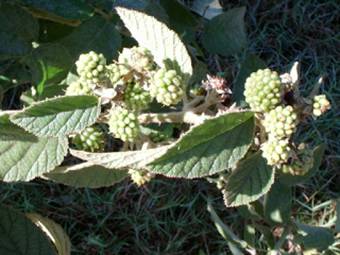RUBUS ERYTHROCLADUS AND RUBUS SELLOWII
POPULAR NAMES: Framboesa verde, Framboesa branca, green raspberry or white raspberry for Rubus erythrocladus and Liana Raspberry or Grape liana from the thorny forest for R. sellowii
ROSACEAE
|
Liana Raspberry (R. sellowii) |
Green Raspberry (R. erytrocladus) |
INDIGENOUS NAME: Both plants receive the name of CAPINURÍBA meaning "herbs covered with spines on bunches of fruit" is derived from four words of Tupi Guaraní: CAA - herb, leaf or stalk, PINÛ - nettle or spiny, ARY - bunch, IBA - fruit.
Origin: The 2 plants are representatives of 5 species from Brazil, occurring in riparian forests or edges of the higher altitude cloud forests of the states of São Paulo, Rio de Janeiro, Minas Gerais and the entire region south of Brazil.
Characteristics:
The raspberry is a liana of perennial shrub, climbing and much branched with
branches forming tussocks of
Planted in the site of Frutas Raras: Both species were planted in September 2001, both species flowered in 2002, and bear fruit every year.
Tips for
cultivation: Subtropical
plant, resistant to frost to -3°C (27°F), can be grown throughout the
country, at any altitude; adapts to different types of soils that are rich
in organic matter and with good natural moisture. It
can be grown in full
sun to shaded environment.
Begins to bear fruit the second year after planting.
The plants begin to
fruit in the age of
Propagation:
The plant is propagated
by seeds that germinate in
Planting: Should
be planted in place a
final space of 3 x
Cultivating: When
the fertilizer, it is with
Uses: The fruit is consumed in-kind, can be used for the manufacture of jams, yoghurts, juices and ice creams.
Flowering in the site of Frutas Raras: September to January.
Fruiting in the site of Frutas Raras: The liana raspberry produces in October and November and the green raspberry produces in several seasons.
BUY THE BOOK “COLECIONANDO FRUTAS”
Back to the seedlist (English) or back to Rosaceae (Portuguese)

